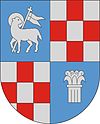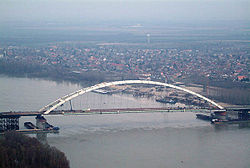- Dunaújváros
-
Dunaújváros The bridge on the Danube 
Coat of armsLocation of Dunaújváros Coordinates: 46°58′50″N 18°54′46″E / 46.98065°N 18.91268°ECoordinates: 46°58′50″N 18°54′46″E / 46.98065°N 18.91268°E Country  Hungary
HungaryCounty Fejér Area – Total 52.66 km2 (20.3 sq mi) Population (2011) – Total 48,104 – Density 922/km2 (2,388/sq mi) Time zone CET (UTC+1) – Summer (DST) CEST (UTC+2) Postal code 2400 Area code(s) 25 Dunaújváros (Dunapentele, 1951–1961 Sztálinváros) is a Hungarian city in Central Transdanubia, along the Danube river. It is in Fejér county.
Contents
History
Dunaújváros is one of the newest cities of the country. It was built in the 1950s during the industrialization of the country under Socialist rule, as a new city next to an already existing village, Dunapentele.
Dunapentele
Dunapentele was not built on until the 1950s. The construction started on the Danube's right side. The area has been inhabited since ancient times. When Western Hungary was a Roman province under the name Pannonia, a military camp and a town called Intercisa stood in this place, at the border of the province. The Hungarians conquered the area in the early 10th century. The village Pentele, named after the medieval Greek saint, Pantaleon, was founded shortly after.
Between 1541 and 1688 the village was under Ottoman rule, and during the 15-year war it was completely destroyed. During the freedom fight led by Prince Francis II Rákóczi the place was deserted again. In the 18th century the village began to prosper. In 1830 the village got the right to hold two market days every week. In 1831 there was a cholera epidemic and the peasants revolted. In 1833 Pentele was granted town status (oppidum) by Ferdinand V. The citizens took part in the freedom fight in 1848-49.
Dunaújváros
After the Second World War the new, Communist government started a major industrialisation programme, in support of its rearmament efforts. In 1949 Dunaújváros was chosen as site of the largest iron and steel works. Originally they were to be built close to Mohács, but the Hungarian-Yugoslavian relations worsened, and this new site was chosen, farther away from the Yugoslav border. The city was designed to have 25.000 residents.
The construction of the city began on May 2, 1950 near Dunapentele. Within one year more than 1000 housing units were built and the factory complex was under construction. The city took the name of Joseph Stalin officially on April 4, 1952; its name was Sztálinváros, "Stalin City" as a parallel to Stalingrad in the USSR.
The metal works were opened by 1954. The city had a population of 27,772 at this time; 85% of them lived in nice, comfortable apartments, while about 4,200 people still lived in uncomfortable barracks which originally provided "homes" for the construction workers.
In the middle of the 1950s, public transport was organized, buses carrying 24,000 passengers each day. During the 1950s many cultural and sports facilities were built, the Endre Ságvári Primary School being the largest school in Central Europe in the 1960s. The official and obligatory architectural style and art movement of the communist system was the socialist realism. Per definition the style’s meaning was communist, its form was national, and its preferred mode of representation was the allegory. There are several public statues and reliefs in the town, which represent the allegoric union of workers, peasants and intellectuals, surrounded by traditional folk motifs. Thanks to the inspiration of Bauhaus the buildings and monuments of this era (1949-56), like the forge, the cinema, the theatre, the hospital and the city’s schools where characterized by a structural functionalism, but the ideological function resulted classicist decorations, like columns, tympanums and arcades, because of which the informal name of the style became ‘Stalin’s Baroque’.
In 1956, the construction was hindered by an earthquake and a flood, and in October by the start of the 1956 Hungarian Revolution. During the revolution the city used its historical name Dunapentele again. The Rákóczi radio station, which was created by the revolutionaries, was broadcasting from Dunapentele (in fact from a bus that was constantly moving around in the city so that it couldn't be located.) Even though the citizens of Dunapentele tried to defend their city, the Soviet army occupied the city on November 7, 1956. The city fell under martial law, Russian tanks were standing everywhere.
After the revolution the city was still the "trademark city" of socialism in Hungary, and was presented as such to foreign visitors. Among the visitors were Yuri Gagarin and the Indonesian president Sukarno. The city also provided scenery to popular movies.
In 1960, the ten-year-old city already had 31,000 residents to celebrate its anniversary.
On November 26, 1961 the city's name was changed to Dunaújváros (Duna|új|város meaning Danube-new-city; "New City upon Danube". See also Tiszaújváros) as a consequence of Stalin's death (1953) and the Hungarian Revolution (1956).
In 1990 it became a city with county rights – as one of the then four, now five cities in the country that have this status but are not county capitals –, in accord with a new law that granted this status to all cities with a population over 50,000. Even though the population of Dunaújváros has been under 50,000 since 2008, it has kept its status as a city with county rights (along with Hódmezővásárhely, which is in a similar situation).
The DUNAFERR factory complex is still is a determinant enterprise in the Hungarian steel industry, and a major employer in the area.
Today, "New Danube City" is home to many new infrastructures (Pentele Bridge, direct highway link between Budapest and Dunaújváros) and the new South Korean Hankook factory, Europe's biggest tire factory of Hankook. This and other projects make Dunaújváros a new Hungarian boomtown.
Thanks to its formal political and economic importance, the communist urban design, the socialist realist architecture and its unique atmosphere the town is the considerable memento of communism. Many of the half-century old buildings have received the protection of historic monuments, and the town is in the focus of growing touristic interest.
Demographics
Historical populations Year Pop. ±% 1949 3,949 — 1960 30,976 +684.4% 1970 45,129 +45.7% 1980 60,736 +34.6% 1990 59,028 −2.8% 2001 55,309 −6.3% 2011 48,104 −13.0% In 2001 Dunaújváros had 55,309 residents (92.5% Hungarian, 0.6% Roma, 0.6% German, 6.3% other).[1] Religions: 38.9% Roman Catholic, 8.3% Calvinist, 2% Lutheran, 37.8% Atheist, 0.2% other, 12.8% no answer.[2][3]
Known people from Dunaújváros
- Márton Vas (born 1980), ice hockey player
- János Vas (born 1983), ice hockey player
- Balázs Ladányi (born 1976), ice hockey player
- Imre Peterdi (born 1980), ice hockey player
- Tamás Lencsés (born 1979), ice hockey player
- Lajos Tőkési (born 1975), ice hockey player
- Viktor Tokaji (born 1977), ice hockey player
- Viktor Szélig (born 1975), ice hockey player
Gallery
International relations
Main article: List of twin towns and sister cities in HungaryTwin towns — sister cities
Dunaújváros is twinned with:
See also
References
External links
- Official site (Hungarian only)
- Dunaújváros 2400 (detailed history, Hungarian only, with lots of pictures)
- Portal site (Hungarian only)
- Video news portal (Hungarian only)
- Statue park
- Bridge in Dunaújváros
- Aerial photography: Dunaújváros
- The city features prominently in the film The Ister. Official site
Counties of Hungary Counties Bács-Kiskun · Baranya · Békés · Borsod-Abaúj-Zemplén · Csongrád · Fejér · Győr-Moson-Sopron · Hajdú-Bihar · Heves · Jász-Nagykun-Szolnok · Komárom-Esztergom · Nógrád · Pest · Somogy · Szabolcs-Szatmár-Bereg · Tolna · Vas · Veszprém · Zala
Urban counties Békéscsaba · Budapest (capital) · Debrecen · Dunaújváros · Eger · Érd · Győr · Hódmezővásárhely · Kaposvár · Kecskemét · Miskolc · Nagykanizsa · Nyíregyháza · Pécs · Salgótarján · Sopron · Szeged · Székesfehérvár · Szekszárd · Szolnok · Szombathely · Tatabánya · Veszprém · ZalaegerszegCategories:- Socialist planned cities
- Populated places in Fejér county
- Populated places established in the 1950s
- Populated places on the Danube
- Planned cities in Hungary
Wikimedia Foundation. 2010.













